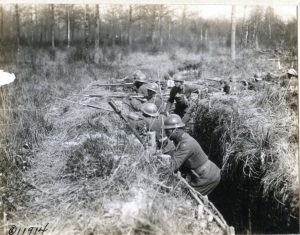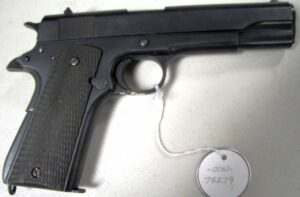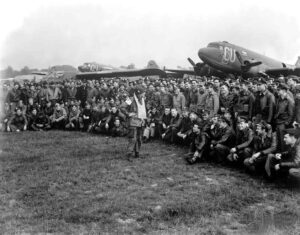Throughout the history of warfare, there has been a desire for religious guidance and assistance during man’s most difficult times. These religious men not only helped in administering comfort and spiritual peace to their flocks, but at times led them into battle, assisted the wounded, and sometimes paid the ultimate sacrifice for their God and for their country.
America’s first Army chaplains made their appearances during the first battles of America’s War for Independence. In the Battles of Lexington and Concord in April 1775, much of the clergy around the pro-independence areas in Massachusetts and other states, including Joseph Thaxter and Philips Payson, not only gave religious aid but carried arms and led their own congregations into battle for the cause of freedom and liberty. Because of this tradition of bravery and courage under fire, the United States Army Chaplaincy grew in fame. The clergy has been by the sides of soldiers through all the bloody and distinguished engagements that the United States has fought since the Revolutionary War. They cared for the dead, administered rites, and, in some instances, took up arms against the enemy.
During the turmoil that surrounded the Vietnam War in the 1960s, the U.S. Army chaplains served their country as with other previous conflicts in America’s history. It was in the Vietnam War that Chaplain (MAJ) Charles J. Watters saved many of the lives of his own flock and sacrificed his own life for the greater good.
Born in Jersey City, New Jersey, on 17 January 1927, Watters was ordained a Roman Catholic priest in 1953 and served in parishes in Jersey City, Rutherford, Cranford, and Paramus. In 1962, he became a chaplain in the New Jersey Air National Guard. In 1964, Watters entered the Army as a chaplain at Fort Dix, New Jersey.
In July 1966, Chaplain Watters was assigned to the Republic of Vietnam and served with Company A, 173d Support Battalion, 173d Airborne Brigade. Although he was officially assigned to the 173d Support Battalion, Watters often accompanied the brigade’s line units into the field. In July 1967, after completing his twelve-month tour, he voluntarily extended his tour by another six months.
In November 1967, Chaplain Watters was with 2d Battalion, 503d Infantry, as the battalion took part in the bloody fighting for Hill 875 around Dak To. For Watters, the culmination of the battle came on 19 November. During that day, an intense fire fight broke out with the enemy forces. Without thinking of his own safety, Watters began to rush out on the battle field to help collect the dying and wounded and bring them to safety. Completely exposed, Chaplain Watters administered the Sacrament of Last Rites to his dying men. Every time his unit began to charge the front line, Watters was ahead picking up the wounded and administering the sacraments to those who had fallen. He also helped carry others to safety, including a paratrooper who was in shock and unable to move from his exposed position.
After hours of intense fighting and with the perimeter of the battlefield in a state of constant confusion, Chaplain Watters continued to maintain his composure in a time of severe crisis. For hours after the initial fighting, he kept venturing out between friendly and enemy lines picking up the wounded, providing the exhausted soldiers with food and water, administering the sacraments, and helping the medics give aid to the wounded. There were even efforts to try to restrain Chaplain Watters from his heroic and courageous deeds because of his vulnerability to enemy and friendly fire. Sadly, Watters himself became a victim of the battle raging on Hill 875 and did not survive the day.
Chaplain Watters deeds were not in vain. He helped to save many men from death and comforted those who were dying. For his own courage and bravery, he was posthumously awarded the Medal of Honor on 4 November 1969 “for his conspicuous gallantry…unyielding perseverance and selfless devotion to his comrades.” These simple yet somber words are found on his Medal of Honor citation. Chaplain Charles Watters was the first Army chaplain to receive the Medal of Honor since the Civil War. Only five Army chaplains have ever received America’s highest military decoration. In the years following Watters’ death, the U.S. Army Chaplain Center and School renamed its building Watters Hall. In addition, P.S. 24, a public school in Jersey City, Watters’ hometown, was renamed Chaplain Charles J. Watters School in 1988.
Chaplain Charles Watters is one of the best examples of how the U.S. Army chaplains serve their men and their country with gallantry and conspicuous courage. Chaplain Watters will always be remembered by the those he saved in a severe time of crisis. Because of this, he will also be remembered as one of the Army’s greatest soldiers.



